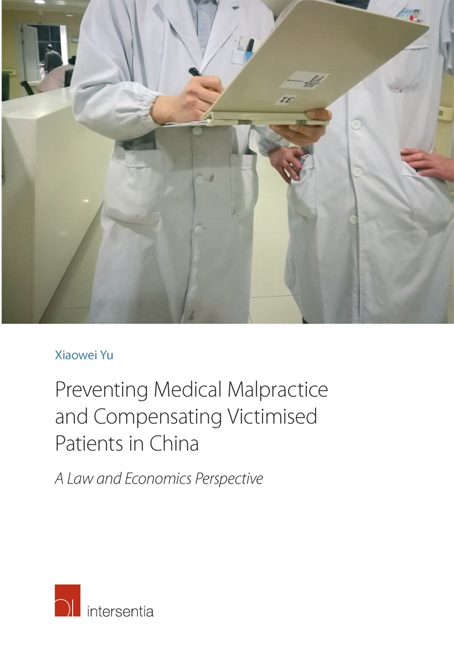 Preventing Medical Malpractice and Compensating Victimised Patients in China
Preventing Medical Malpractice and Compensating Victimised Patients in China Book contents
- Frontmatter
- Acknowledgements
- Contents
- Abbreviations
- List of Figures and Tables
- Chapter 1 Introduction
- Part I Legal Remedies for Medical Malpractice in China
- Part II Economic Theories and Empirical Evidence
- Introductory Note
- Chapter 7 Preventing Medical Errors through Tort Law – Theoretical Models
- Chapter 8 Preventing Medical Errors through Tort Law – Empirical Evidence and Updated Models
- Chapter 9 Preventing Medical Errors through Alternative Regimes
- Chapter 10 The Fault-Based Compensation Mechanisms for Iatrogenic Injuries
- Chapter 11 Medical Compensation Mechanisms Not Based on Fault
- Part III Applying the Economic Observations to China
- Summary
- Bibliography
- Appendix 1 Legislation
- Appendix 2 Cases
- Appendix 3 Semi-Structured Interviews
- Valorisation Addendum
- Curriculum Vitae
Chapter 9 - Preventing Medical Errors through Alternative Regimes
from Part II - Economic Theories and Empirical Evidence
Published online by Cambridge University Press: 29 September 2018
- Frontmatter
- Acknowledgements
- Contents
- Abbreviations
- List of Figures and Tables
- Chapter 1 Introduction
- Part I Legal Remedies for Medical Malpractice in China
- Part II Economic Theories and Empirical Evidence
- Introductory Note
- Chapter 7 Preventing Medical Errors through Tort Law – Theoretical Models
- Chapter 8 Preventing Medical Errors through Tort Law – Empirical Evidence and Updated Models
- Chapter 9 Preventing Medical Errors through Alternative Regimes
- Chapter 10 The Fault-Based Compensation Mechanisms for Iatrogenic Injuries
- Chapter 11 Medical Compensation Mechanisms Not Based on Fault
- Part III Applying the Economic Observations to China
- Summary
- Bibliography
- Appendix 1 Legislation
- Appendix 2 Cases
- Appendix 3 Semi-Structured Interviews
- Valorisation Addendum
- Curriculum Vitae
Summary
INTRODUCTION
Although the fault-based malpractice system appears to be cost-effective at preventing medical errors (i.e. its deterrence benefits slightly exceed its costs as the American data show), the existence of considerable costs of defensive medicine and administrative costs lead us to the question whether there is any alternative regime to the tort system that will achieve greater efficiency (part of Sub-question (2-a)). In the literature, two alternative regimes are often discussed – the contractual approach and regulation.
At one extreme, proponents of the contractual approach emphasise that informed patients will only purchase the desired level of care (or risk of medical malpractice) in their best interests, and social welfare will be maximised in a free health market. The contractual approach is relevant for China in that a small part of the Chinese health care system is based on the free market – services provided by for-profit private hospitals. However, this approach does not seem fit for the part of the health care sector where services are provided by not-for-profit hospitals and prices are normally regulated.
At the other extreme, proponents of regulation do not believe individuals can make informed decisions in their best interest, and some government interventions seem theoretically justified. This approach is highly relevant for China, since China has a deep-rooted tradition of strict governmental regulation and a regime of regulating health care provision has been developing in China for decades.
This Chapter will review arguments for and against the contractual approach (Section 2) and quality regulation (Sections 3-6), and conduct a critical evaluation of them against Calabresi's goals of accident cost avoidance. Section 3 will provide a general overview of the regulation of the medical profession. Licensing and quality/safety regulation will be examined separately in Section 4 and Section 5. The pros and cons of public regulation and self-regulation will be addressed in Section 6. The final Section 7 concludes.
THE CONTRACTUAL APPROACH: A DESIRABLE ALTERNATIVE?
INTRODUCTION
The contractual approach was proposed against a background of the medical malpractice crisis in the US. In view of the deficiencies of the fault-based malpractice system, some scholars turned their gaze to contracts. Basically, there are two types of contractual approaches to medical malpractice liability. One group of scholars maintained that contracting out of or over malpractice Liability between individual patients and health care providers may enhance social welfare.
Information
- Type
- Chapter
- Information
- Preventing Medical Malpractice and Compensating Victimised Patients in ChinaA Law and Economics Perspective, pp. 303 - 350Publisher: IntersentiaPrint publication year: 2017